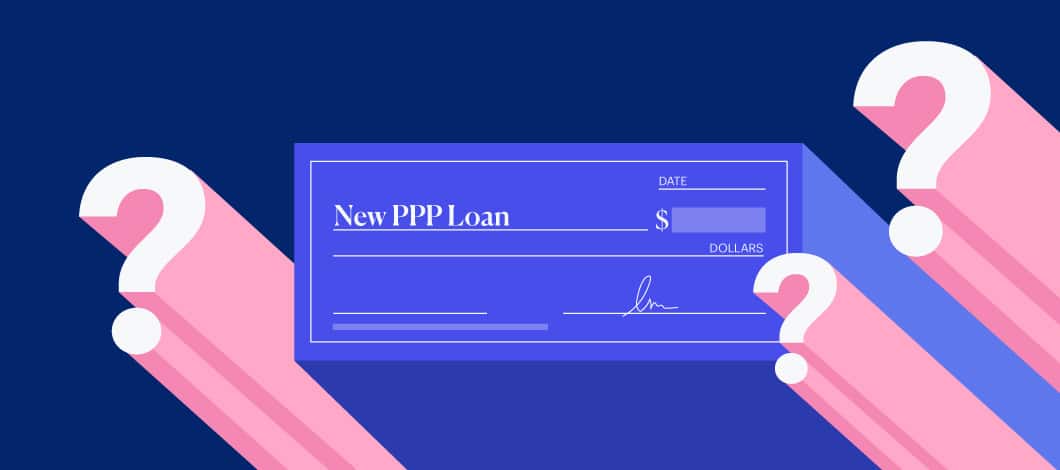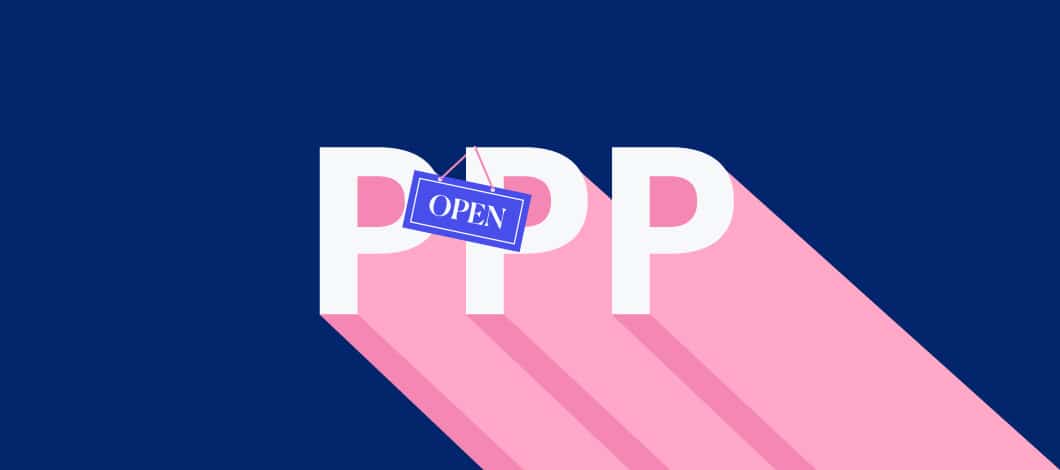The U.S. government’s Paycheck Protection Program (PPP) was updated on Dec. 27, 2020.
Here’s what you need to know about the new PPP loan program. We’ll look at what’s different about the new program, including how the changes affect second loan eligibility, cap limits and loan forgiveness.
What’s Different About PPP in the New COVID Relief Bill?
The PPP was created by the Coronavirus Aid, Relief and Economic Security (CARES) Act passed on March 27, 2020. It has been extended and amended multiple times since then.
The PPP initially extended $349 billion in funding to provide small businesses with loans for the purpose of covering payroll and overhead costs in order to keep workers employed. Under the original terms, loans were available to small businesses with 500 or fewer employees, or designated numbers of employees for certain industries.
Loans were extended in amounts up to $10 million for 2-year terms at 1% interest, with the first payment deferred for 6 months. Loan forgiveness was available if proceeds were used for payroll costs and other designated operating expenses in the 8 weeks after loan origination.
The CARES Act 2 update passed in December includes some new stimulus bill details which extend the PPP program with certain amendments. The second round of PPP funding earmarks up to $284 billion for job retention and certain other expenses through March 31, 2021. Notably, it includes provisions that allow eligible existing (First Draw) PPP borrowers to apply for Second Draw PPP Loans.
Major PPP loan second round updates include:
- Certain existing borrowers can request a modification of the amount for their First Draw PPP Loan
- Certain existing borrowers can apply for a Second Draw PPP loan
- Eligibility has been expanded to include 501(c)(6)s nonprofits (business leagues), direct marketing organizations, housing cooperatives and certain other organizations
- For purposes of calculating revenue to determine eligibility, the definition of gross receipts has been clarified
- Greater flexibility is allowed for covering costs of seasonal employees
- Loans can cover certain additional expenses, including operations costs, worker protection costs, supplier costs and property damage costs from vandalism and looters
- For businesses in industries falling under North American Industry Classification System (NAICS) code categories which begin with 72 (Accommodations and Food Services), the maximum loan amount has been increased from 2.5 times average monthly payroll costs to 3.5 times
- New First Draw PPP Loans remain capped at $10 million, while Second Draw PPP Loans are capped at $2 million
- Borrowers can set the covered period for loan forgiveness to 8 or 24 weeks
- The PPP loan forgiveness process has been simplified
Below are some practical highlights of how the changes in the second round of PPP loans affect applicants.

Can You Still Apply for a First Draw PPP Loan?
If your business has been affected by COVID-19 and you haven’t previously been approved for a PPP loan, you can still apply for a First Draw PPP Loan under the second PPP loan update until March 31, 2020. To qualify for new PPP loan, your business must fall into one of the following categories:
- A sole proprietor, independent contractor or self-employed person
- A small business that meets size criteria set by the Small Business Administration (SBA) for either your industry size standard or alternative size standard
- A business, 501(c)(3) nonprofit organization, 501(c)(19) veteran organization or tribal business concern (Sec. 31(b)(2)(C) of the Small Business Act) which has the greater of 500 employees or the SBA industry size standard if more than 500
- Any Accommodations and Food Services business with a NAICS code which begins with 72, has more than one physical location and employs fewer than 500 per location
Also, if you are an existing PPP borrower who didn’t receive loan forgiveness by Dec. 27, 2020, you can:
- Reapply for a First Draw PPP Loan if you previously returned some or all of your loan funds
- Under certain circumstances, request to modify your First Draw PPP Loan amount if you previously didn’t accept the full amount
The new round of First Draw PPP Loans was originally available through a limited network of lenders starting Jan. 11, 2021, but it opened to all qualifying lenders on Jan. 19.
Can You Get a Second PPP Loan?
If you’re an existing borrower under a First Draw PPP loan, you can apply for a Second Draw PPP Loan if you meet certain qualifying criteria:
- You have previously received a First Draw PPP loan and have used or will use the full amount only for authorized uses
- You have no more than 300 employees
- You can demonstrate a reduction in gross receipts of at least 25% between comparable quarters in 2019 and 2020
For purposes of calculating gross receipts, these include all revenue in whatever form received or accrued (in accordance with your accounting method) from any source, including sales of products or services, interest, dividends, rents, royalties, fees or commissions, with totals reduced by returns and allowances. Forgiven First Draw PPP Loans aren’t included for purposes of calculating 2020 gross receipts.
The second round of PPP loans seeks to extend special consideration to businesses hardest hit by the pandemic. At least $25 billion has been earmarked for Second Draw PPP Loans to eligible borrowers with a maximum of 10 employees or, for loans of up to $250,000, to eligible borrowers in low- or moderate-income neighborhoods.
The window to apply for Second Draw PPP Loans opened on Jan. 13 and runs through March 31, 2021.
What Can PPP Loans Be Used for?
Both First Draw PPP Loans and Second Draw PPP Loans can be used to pay for:
- Payroll costs, including benefits
- Mortgage interest, rent, utilities and worker protection costs related to COVID-19
- Uninsured property damage costs caused by vandalism or looting in 2020
- Certain supplier costs and expenses for operations
You must spend at least 60% of your funds on payroll within your covered period of 8 or 24 weeks to qualify for loan forgiveness.
What Are the Terms of PPP Loans?
PPP loans have the following general terms:
- Interest rate of 1%
- Maturity of 2 years for loans issued before June 5, 2020 and 5 years for loans issued after that date
- Loan payments will be deferred for borrowers who apply for loan forgiveness until SBA remits the borrower’s loan forgiveness amount to the lender
- For borrowers who don’t apply for loan forgiveness, payments are deferred 10 months after the end of the covered period for the borrower’s loan forgiveness (either 8 weeks or 24 weeks)
- No collateral or personal guarantees are required
- Neither the government nor lenders shall charge small businesses any fees
Most terms generally apply to both First Draw and Second Draw PPP Loans. However, there are some important differences between First Draw and Second Draw PPP Loans, notably:
- First Draw PPP Loans have a cap of $10 million, while Second Draw PPP Loans have a cap of $2 million.
- First Draw PPP Loans are capped at 2.5 times average monthly payroll costs, while Second Draw PPP Loans are capped at 2.5 times for most business or 3.5 times for businesses in Accommodations and Food Services industries falling under NAICS code categories which begin with 72
These are some outstanding highlights. See your lender for complete details.

Has There Been a PPP Loan Forgiveness Update?
Under the latest PPP forgiveness update, you can either:
- Apply for loan forgiveness until the SBA remits your loan forgiveness amount to your lender
- Without applying for loan forgiveness, automatically have payments deferred for 10 months after the end of the covered period for your loan forgiveness (either 8 weeks or 24 weeks depending on the terms you selected)
To qualify for loan forgiveness, you must spend at least 60% of your funds on payroll during the covered period of 8 or 24 weeks. Documenting this for loan forgiveness has been simplified for borrowers receiving $150,000 or less. Lenders falling in this category must simply submit a 1-page certification form describing the number of employees retained because of the loan, the amount spent on payroll and the total amount of the loan.
Additional documentation may be needed in some cases to document revenue loss or meet statutory or regulatory requirements.
How Long Do I Have to Apply for a PPP Loan?
Under current legislation, you can apply for a First Draw PPP Loan or a Second Draw PPP Loan until March 21, 2021.
How Do I Apply for a PPP Loan?
You can find a PPP lender by visiting SBA Lender Match. If you want to begin preparing your application and collecting needed information, you can download a form for a PPP First Draw Loan or PPP Second Draw Loan application. You will need documentation such as tax filings and payroll records to verify eligibility and establish your qualifying payroll amount.
What Can I Do If I’m Not Eligible for a New PPP Loan?
If you’re eligible for a PPP loan but you still require financing, you may still be eligible for other SBA loans, other loans or other forms of small business financing. For example, you may qualify for a merchant cash advance, a form of financing which extends you cash on the strength of your future revenue projections.
If you’re wondering what forms of financing you qualify for, take 2 minutes to fill out our online application and we’ll let you know what options may be available to you.










